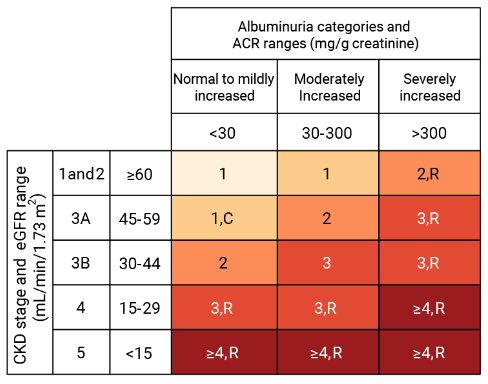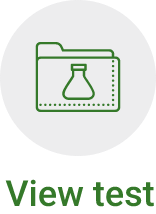



Featured resources
![]() Quality Reporting: Test Code Reference Guide
Quality Reporting: Test Code Reference Guide
Improve quality metrics by closing the gap in care with chronic kidney disease testing
The Test Code Reference Guide aims to drive patient outcomes while helping you optimize reimbursement. Access the guide for more on testing that supports your chronic kidney disease quality metrics reporting.
Learn more![]() CKD Risk Map
CKD Risk Map
Risk stratify patients using the Kidney Profile with enhanced reporting
To aid your practice, the National Kidney Foundation and the Kidney Disease: Improving Global Outcomes (KDIGO) initiative have developed a risk map and follow-up testing guideline.
Access the CKD risk map![]() CKD White Paper
CKD White Paper
Top 5 questions primary care physicians ask about chronic kidney disease testing
Our medical experts explain why serum creatinine with estimated glomerular filtration rate (eGFR) and urine albumin-creatinine ratio (uACR) testing must be used together to diagnose and monitor CKD, among other topics.
Download White Paper![]() CKD Webinar
CKD Webinar
The Continuum of Chronic Kidney Disease Care: From Identification to Referral
Find out how early identification of risk can help you get ahead of chronic kidney disease.
Bridge the gap in CKD testing
The majority of patients at risk for CKD are not receiving the recommended testing.14,15 Guideline-based monitoring with the Quest Diagnostics Kidney Profile offers enhanced reporting that empowers primary care providers to:

Easily interpret results

Determine follow-up testing frequency

Identify risk earlier
Put your patients on a path to better health

Low risk: monitor yearly if evidence of kidney damage (eg, indicated by imaging or biopsy)
Moderately high risk: monitor yearly
High risk: monitor 2 times yearly
Very high risk: monitor 3 times yearly
Very high risk: monitor 24 times yearly
The National Kidney Foundation and Kidney Disease: Improving Global Outcomes (KDIGO) Initiative recommend a frequency of monitoring CKD based on Serum Creatinine with effective Glomerular Filtration Rate (eGFR) and Urine Albumin-Creatinine Ratio (uACR).
| Test Name | Kidney Profile |
|---|---|
| Test Description | This Profile combines 2 common tests—eGFR and uACR—to support early detection of CKD. This profile supports the National Kidney Foundation initiative to drive adoption of such protocols to facilitate appropriate test ordering to address early detection of CKD. |
| Test Code | 39165 |
| CPT | 82043, 82565, 82570 |
| Preferred Specimen | 1 mL serum and 10 mL random urine collected in plastic urine container |
| Alternative Specimen | Serum Separator Tube (SST®) and Plastic urine container |
| Transport Tempature | Refrigerated (cold packs) |
| Specimen Stability | Room tempature: 7 days; Refrigerated: 7 days; Frozen: 28 days |
Get the insights you need to get ahead of CKD
Request more information from your Quest representative
Request InformationNew customer? Sign up to be contacted by your local Quest representative
Sign UpPowering affordable care through guideline-based testing
Quest is committed to supporting you with the guideline-based testing and resources you need to guide your patients’ kidney health
| Test Name | Test Description | Test Code | CPT Code(s) |
|---|---|---|---|
| Kidney Profile* | Creatinine (includes eGFR) Albumin, Random Urine with Creatinine (includes Albumin/Creatinine Ratio) | 39165 | 82043, 82565, 82570 |
| Cystatin C with eGFR | Marker of renal function, Cystatin C is a low molecular weight protein that, like creatinine, is freely filtered by kidneys | 94588 | 82610 |
*Panel components 6517-Albumin, Random Urine with Creatinine; 375-Cratinine, Serum: Panel components may be ordered separately.
- CDC. Chronic kidney disease in the United States, 2021. Updated March 4, 2021. Accessed April 2, 2021. https://www.cdc.gov/
kidneydisease/ publications-resources/ 2019-national-facts.html - National Kidney Foundation. Laboratory medicine impact on population health implementing the kidney profile. https://www.kidney.org/
sites/ default/ files/ 02-11-8160_hbj_cmo_ascp_poster3.pdf. - National Kidney Foundation. CKDIntercept Laboratory Engagement Initiative. https://www.kidney.org/
CKDintercept/ laboratoryengagement
Image content features models and is intended for illustrative purposes only.

